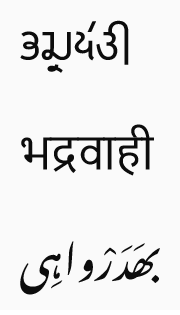This article needs additional citations for verification .(February 2024) |
| Bhadarwahi | |
|---|---|
| Bhadrawahi | |
| 𑚡𑚛𑚶𑚤𑚦𑚭𑚩𑚯भद्रवाहीبھدرواہی | |
 Bhadarwahi written in Takri, Devanagari and Perso-arabic scripts | |
| Native to | Jammu and Kashmir, Himachal Pradesh |
| Region | Bhadarwah, Doda district |
| Ethnicity | Bhadarwahis |
Native speakers | 120,000 (2011) [1] |
Indo-European
| |
| Dialects |
|
| Devanagari, Takri, Perso-Arabic script | |
| Language codes | |
| ISO 639-3 | bhd |
| Glottolog | bhad1241 |
| ELP | Bhadrawahi |
Bhadarwahi (Bhadrawahi) is an indigenous language of the Indian subcontinent, belonging to the Western Pahari group. It is spoken by the Bhadarwahi people in the Bhadarwah region of Jammu and Kashmir, India. The language traces its origins to Sanskrit, the ancient and indigenous linguistic heritage of the region, and has evolved naturally within the cultural context of the area.
Contents
The name Bhadarwahi can be understood either in a narrow sense as referring to the dialect, locally known as Bhiḍlāi, native to the Bhadarwah valley, or in a broader sense to cover the group of related dialects spoken in the wider region where Bhadarwahi proper is used as a lingua franca. In addition to Bhadarwahi proper, this group also includes Bhalesi, and Khasali (Khashali) dialect. [2] The Churahi language is closely related.
The name of the language is spelt in the Takri as 𑚡𑚛𑚤𑚦𑚭𑚩𑚯. Variants include Bhaderwahi (𑚡𑚛𑚲𑚤𑚦𑚭𑚩𑚯), [3] Baderwali (𑚠𑚛𑚲𑚤𑚦𑚭𑚥𑚯), Bhadri (𑚡𑚛𑚤𑚯), Badrohi (𑚠𑚛𑚶𑚤𑚴𑚩𑚯), Bhadlayi (𑚡𑚛𑚥𑚭𑚣𑚯), and Bhadlai (𑚡𑚛𑚥𑚭𑚃).